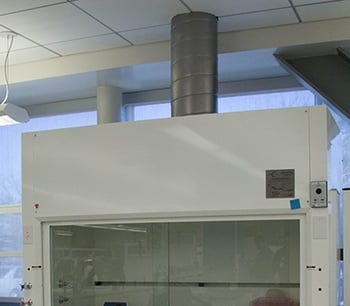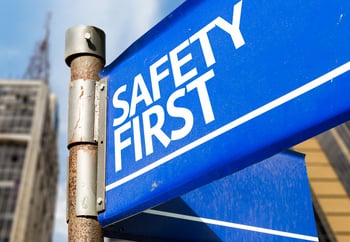Fume hoods play one of the most important roles found in laboratory or manufacturing spaces that work with hazardous chemicals.
Through a system of duct work, ventilation devices and an intricate design, fume hoods minimize your workers’ exposure to chemicals through inhalation, skin absorption and ingestion.
Installing the wrong type of hood - or worse, not having one at all - can expose your workers to dangerous substances and severe consequences.
It may seem cut and dry, but understanding exactly how a chemical fume hood works is important so that you can ensure your facility has the correct equipment on hand and that it’s operating effectively.
An Overall Look
 No matter what type of fume hood you have, its main job is to remove vapors, dusts, gases and fumes that are created within the hood.
No matter what type of fume hood you have, its main job is to remove vapors, dusts, gases and fumes that are created within the hood.
The overall design of a hood allows air to flow into it, as an exhaust fan system removes these toxic chemicals.
Though they have the same goal in the end, ducted and ductless fume hoods differ in design and how they are constructed to work.
Ducted fume hoods:
- Have ventilated enclosures and operate within the framework of your building’s infrastructure.
- Pull toxic fumes out of your laboratory through an HVAC system.
- Are designed using a base, work surface, hood, blower and ducting that carries the exhaust fumes outside.
- Must consider the volume of ventilation you need to carry fumes outside and to work properly.
Ductless fume hoods, on the other hand:
- Operate off a carbon filter system, which re-circulates filtered air back into your laboratory.
- Are self-contained, which allows them to be mobile.
- Can be used in laboratories that handle light to moderate chemical loads (no more than 10 chemicals per application, with a volume of approximately 500 mls or less).
Each has its own sets of advantages and disadvantages. Ducted fume hoods, for example, are considered the safest for workers in laboratories. This type of hood is often required in a university setting because it heightens student safety and is easier to maintain.
They also can handle a variety of chemicals, while ensuring little to no contamination in the lab when used properly.
However, they may require infrastructure improvements or additions, such as ductwork, exhaust fans and changes to roofing elements. Because they are more permanent in nature and not mobile, they can be more difficult to install and use more energy overall.
Ductless fume hoods, on the other hand, are easy to install, use less energy and are easily movable or relocatable. They’re a great option for labs that don’t handle as many chemicals or don’t have the space for a full-size ducted unit. They also allow workers to use the hood in different work areas, depending on the need.
However, like ducted fume hoods, they have disadvantages as well. Though they can be a more cost-effective option because they don’t require as large of an installation, they do provide a greater risk of chemical exposure because of their mobile design.
Also, only certain chemicals can be handled in a ductless fume hood, which requires certain filters and filter maintenance. They’re not recommended for constant use, and they cannot handle extreme heating of chemicals.
Deciding which type is best for your workspace is important - not only for the safety of your workers, but for the efficiency of your lab as well. Our article, Laboratory Fume Hood: Ducted Vs. Ductless, offers some questions that will help you determine which is a better fit.
Important Factors
 Now that you understand how fume hoods work, it’s important to know what can hamper their effectiveness - or hinder their ability to work at all.
Now that you understand how fume hoods work, it’s important to know what can hamper their effectiveness - or hinder their ability to work at all.
Before beginning work with a fume hood, lab technicians should go through a checklist to ensure each part of the hood is working.
In the exhaust system, for example, you should check:
- The baffles, which are the movable partitions that create openings in the back of the hood. These keep airflow uniform, which increases efficiency.
- For any obstructions, to ensure airflow is not impeded.
- The airflow monitor, if part of the hood’s design. Checking the status of the airflow monitor is important because the device will alert you if any suspected changes in airflow occur.
Other issues that can affect how a fume hood properly operates include:
- Where it is placed. Follow manufacturer’s guidelines regarding its placement, but in general, all work should be conducted and all apparatus should be kept at least 6 inches back from the hood’s face. Also, reduce any airflow influences, such as doorways and high foot traffic areas.
- If it’s used for storage. You should never store chemicals or lab equipment in hoods if you can avoid doing so since it can impede proper airflow. If large equipment must be stored in the hood, place pieces on blocks to allow air to flow under the equipment.
- Whether there are any spark sources nearby. Electrical receptacles can cause sparks, and therefore fire hazards.
Fume hoods also shouldn’t be used during a power outage, when it’s likely the ventilation in a workspace will not function properly. Because a fume hood relies on exhaust fans to remove toxic substances from the area, operating a fume hood during a power outage could pose a danger to workers.
Implementing procedures at your workplace that ensure fume hoods are properly maintained and used is essential to protecting your workers and following mandated regulations.
Bottom Line
With the right fume hood, your workplace will emphasize safety and efficiency, while placing the welfare of your employees at the top of your priority list. Understanding how a chemical fume hood works is critical to ensure this happens.
Sorting through your options and getting any questions you have about how chemical fume hoods operate can be challenging. However, quality fume hood manufacturers can help you determine which type is best for your space, and answer any questions you have about specifications that meet the requirements of your lab. These include:
- Hood size
- Surface material and fixtures
- Color options
- Base cabinets and accessories
- Budget requirements
Laboratory safety should be your top consideration. Fully understanding how chemical fume hoods function and impact the efficiency of your workspace is a necessary step in securing this important piece in your lab.


